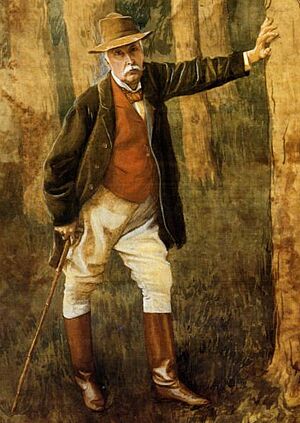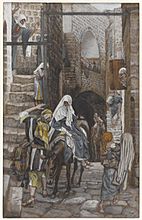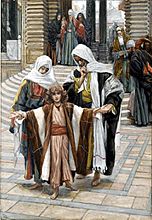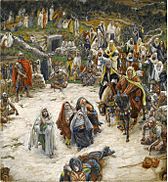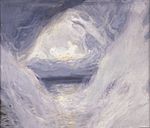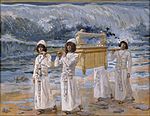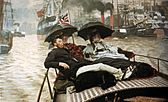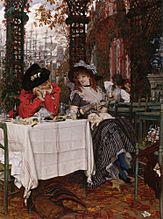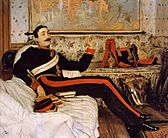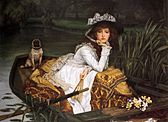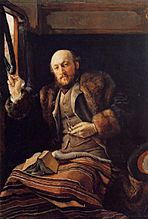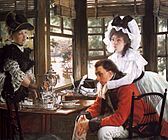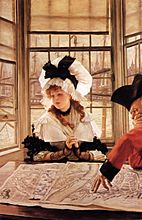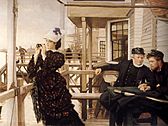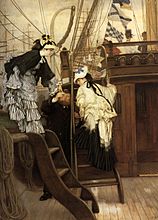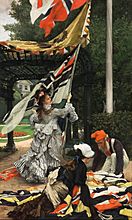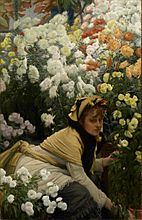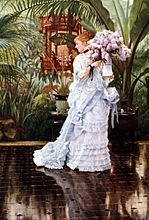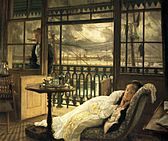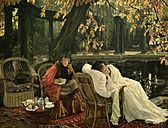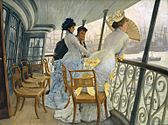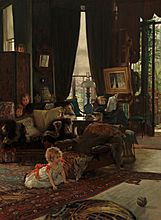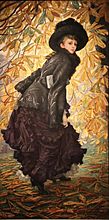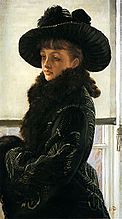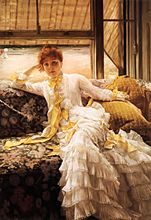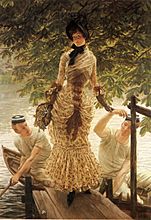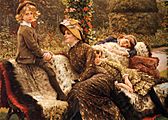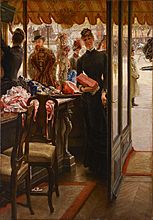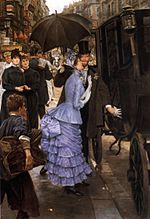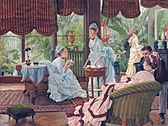James Tissot facts for kids
Quick facts for kids
James Tissot
|
|
|---|---|
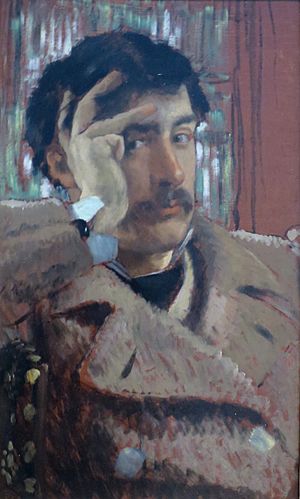
Self-Portrait (1865), oil on canvas, Fine Arts Museums of San Francisco.
|
|
| Born |
Jacques Joseph Tissot
15 October 1836 |
| Died | 8 August 1902 (aged 65) Chenecey-Buillon, French Third Republic
|
| Other names | James Tissot |
| Occupation | painter, illustrator, artist |
James Tissot (born Jacques Joseph Tissot; 15 October 1836 – 8 August 1902) was a famous French painter and illustrator. He was born to parents who worked with clothes and decided to become an artist when he was young. His art combined different styles like realism and early Impressionism.
Tissot is best known for his paintings of everyday life, especially scenes of wealthy European society. He often focused on Victorian fashion and the Belle Époque period. Throughout his life, he also explored many subjects from the Middle Ages, the Bible, and Japanese culture (a style called japonisme).
Tissot fought in the Franco-Prussian War for France. Later, he moved to London in 1871, where he became even more successful as an artist. In London, he met Kathleen Newton, who became his close companion and model until she passed away in 1882. Tissot was also friends with early Impressionist artists like Edgar Degas.
Contents
Early Life and Art Journey
Jacques Tissot was born in Nantes, France. His father, Marcel Théodore Tissot, was a successful fabric merchant. His mother, Marie Durand, helped her husband and designed hats. Tissot's mother was a very religious Catholic and taught him about faith from a young age.
Growing up in Nantes, a port city, likely influenced his paintings of ships and boats later on. His parents' work in fashion also probably inspired him to paint women's clothing in great detail. By age 17, Tissot knew he wanted to be a painter. His father wanted him to go into business, but his mother supported his dream. Around this time, he started using the name James, possibly because he was becoming very interested in English culture.
Starting His Career
Around 1856 or 1857, Tissot moved to Paris to study art. He enrolled at the Ecole des Beaux-Arts. He learned from teachers like Hippolyte Flandrin and Louis Lamothe. Like many young artists, he also studied by copying famous artworks at the Musée du Louvre.
During this time, Tissot met other important artists. These included the American James Abbott McNeill Whistler and French painters Edgar Degas and Édouard Manet.
In 1859, Tissot showed his paintings at the Paris Salon for the first time. He displayed five paintings about the Middle Ages, including scenes from Goethe's Faust. These works showed the influence of Belgian painter Henri Leys, whom Tissot had met earlier that year. The French government even bought one of his paintings, The Meeting of Faust and Marguerite, in 1860.
Later Life and Art Success
Around 1863, Tissot changed his style. He stopped painting medieval scenes and started focusing on modern life and portraits. This change brought him great success and made him a very popular artist.
Tissot was a key figure in Japonisme. This was an art movement inspired by Japanese art and objects that came to Europe after Japan opened up to trade. Tissot often included Japanese items and clothing in his paintings. He also used Japanese art styles in his compositions and angles. His friend Degas even painted a portrait of Tissot sitting under a Japanese screen.
Tissot also had an eventful life outside of art. He fought in the Franco-Prussian War to defend Paris. Later, he was part of the Paris Commune. In 1871, he left Paris for London, possibly for better opportunities. In London, he quickly became known for his paintings of elegantly dressed women in fashionable settings. This was likely influenced by his childhood around his mother's hat business.
By 1872, Tissot bought a house in St John's Wood, a popular area for artists in London. He became very wealthy from his art, earning a large income.
In 1874, Edgar Degas invited Tissot to join the first exhibition of the artists who would become known as the Impressionists. Tissot chose not to join, but he remained close friends with these artists. He visited Berthe Morisot in London and traveled to Venice with Édouard Manet. He also often saw James Abbott McNeill Whistler, who influenced Tissot's paintings of the River Thames.

Around 1875 or 1876, Tissot met Kathleen Newton. She became his close companion and a frequent model for his paintings. She lived with him until her death in 1882 from a lung illness. Tissot often said these years with Newton were the happiest of his life.
After Kathleen Newton's death, Tissot returned to Paris. In 1885, he had a big exhibition called La Femme à Paris (The Woman in Paris). This series showed different types of women in various social and professional scenes. These paintings also clearly showed the influence of Japanese prints in Tissot's work, as he used unusual angles and framing.
- ''La Femme à Paris''
Later Career and Biblical Art
In 1885, Tissot had a renewed interest in his Catholic faith. This led him to spend the rest of his life painting scenes from the Bible. Many of his artist friends were surprised by this change. Tissot moved away from the modern Impressionist styles and returned to more traditional ways of painting.
To help him create his biblical illustrations, Tissot traveled to the Middle East in 1886, 1889, and 1896. He wanted to study the landscapes and people there. His series of 365 watercolor illustrations showing the life of Christ became very famous. They were shown in Paris, London, and New York, receiving great praise. The Brooklyn Museum bought them in 1900. These illustrations were also published in books, bringing Tissot a lot of wealth and fame. In 1894, Tissot received the Legion of Honour, France's highest award.
Tissot spent his final years working on paintings from the Old Testament. He didn't finish the whole series, but he exhibited 80 of these paintings in Paris in 1901.
- The Life of Christ
- Subjects from the Old Testament
-
The Creation, Jewish Museum (New York), 1896 and 1902
Death and Lasting Influence
Tissot passed away suddenly in Doubs, France, on 8 August 1902. He was living in the Château de Buillon, a former abbey he had inherited from his father. His grave is in the chapel on the chateau grounds.
After his death, Tissot's illustrations continued to be widely used. His Life of Christ and Old Testament series became very popular Bible images. In 1906, filmmaker Alice Guy-Blaché used Tissot's Bible art as inspiration for her film The Passion. His images also influenced modern films, such as the design for the Ark of the Covenant in Raiders of the Lost Ark (1981) and the style of The Age of Innocence (1993). In the 20th century, there was a renewed interest in his portraits of fashionable ladies, and these paintings later sold for record prices.
Gallery
See also
 In Spanish: James Tissot para niños
In Spanish: James Tissot para niños
- List of Orientalist artists
- Orientalism




